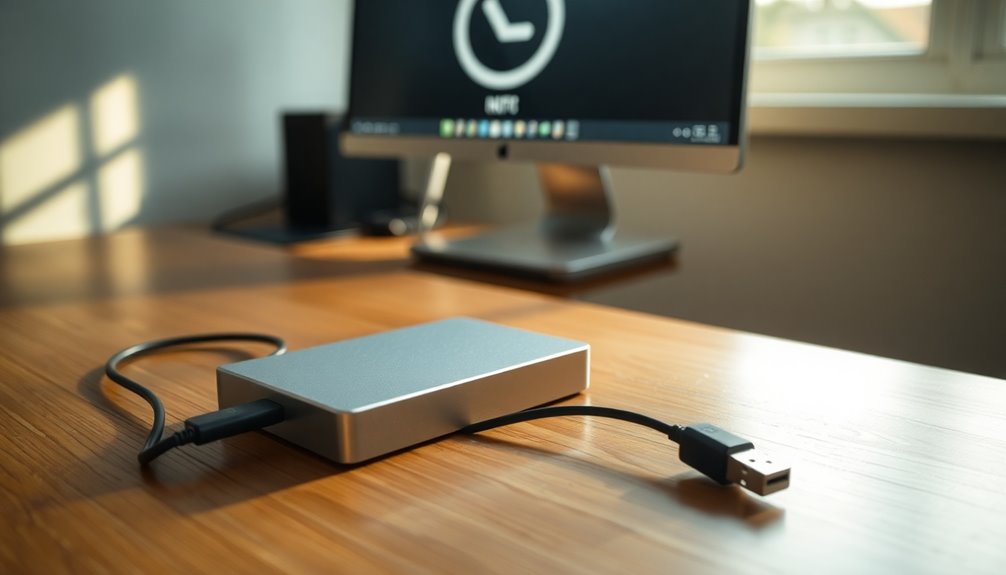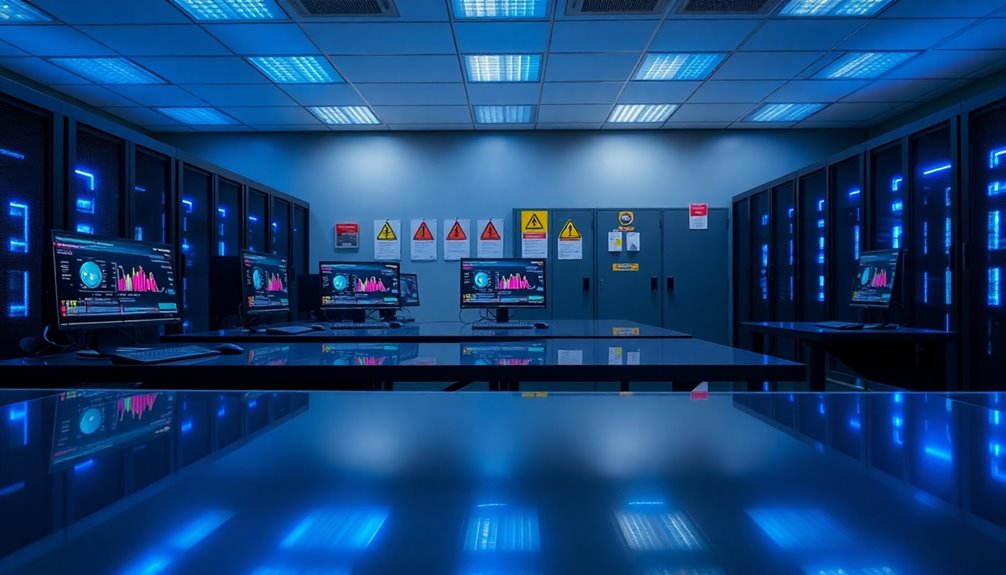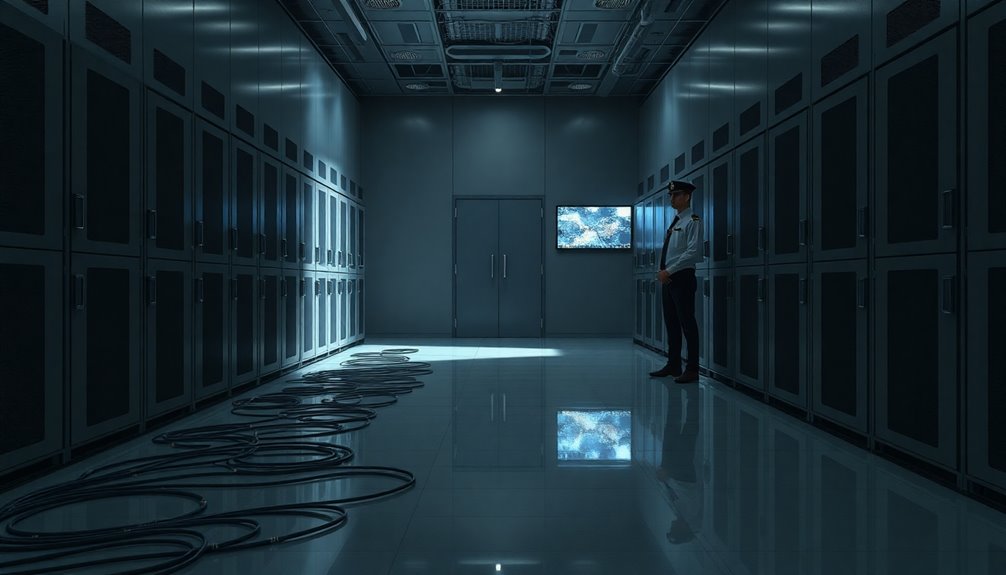An air-gapped system is a secure network that's isolated from unsecured ones, like the Internet. This physical disconnection protects sensitive data from cyber threats and unauthorized access. You'll often find air-gapped systems in high-security fields, such as military, healthcare, and finance. Data transfer is typically done using USB drives or external hard drives, ensuring strict protocols are followed to prevent malware introduction. While air-gapped systems provide enhanced security, they aren't completely immune to breaches, particularly from insider threats. If you want to learn more about their pros, cons, and innovative security solutions, keep going!
Key Takeaways
- Air-gapped systems are isolated from unsecured networks, ensuring maximum security for sensitive data and operations.
- They are physically disconnected from external networks, reducing the risk of cyber threats and unauthorized access.
- Commonly used in military, financial, government, and healthcare sectors to minimize vulnerabilities to attacks.
- Data transfer typically involves secure media like USB drives, with strict protocols to prevent malware introduction.
- Despite isolation, air-gapped systems face risks from physical access, insider threats, and supply chain attacks.
Isolation From Networks

When you think about air-gapped systems, it's essential to understand their complete isolation from networks. These systems are physically disconnected from external networks, including the Internet. You'll find that network interfaces are often unplugged, and wireless connections are disabled to prevent any indirect connectivity. Physical security barriers, like locked rooms, further protect these systems by restricting unauthorized access. On the logical side, network technologies like VLANs and firewalls help separate systems, ensuring that traffic remains controlled and limited. Designing the network architecture involves planning both physical and logical isolation, focusing on unidirectional data flow to prevent data exfiltration. This approach is crucial because air gaps protect sensitive data and critical systems from a wide range of cyber threats. Ultimately, this multilayered approach significantly reduces potential attack vectors, keeping your critical systems secure.
Definition of Air-Gapped Systems

An air-gapped system is a computing environment that remains completely isolated from external networks, ensuring maximum security for sensitive data and operations.
These systems are engineered to minimize vulnerabilities, making them less susceptible to remote attacks like hacking or ransomware. By eliminating external connectivity, you significantly reduce the risk of data breaches and malware infections, enhancing overall security. Virtual air gaps provide dynamic security layers for sensitive data in cloud and remote work settings, mitigating the risk of lateral movement by isolating critical systems from broader networks.
There are various types of air gaps, including physical, logical, and electronic air gaps, each offering different levels of isolation. They're commonly used in military, financial, and critical infrastructure sectors, where protecting sensitive information is crucial.
Though not completely impervious, air-gapped systems provide a formidable defense against many common cyber threats, ensuring the utmost protection for your vital systems.
Physical Data Transfer Methods

Transferring data into and out of air-gapped systems requires meticulous attention to security, as these isolated environments are designed to protect sensitive information from external threats. You'll often use USB drives or external hard drives for this purpose, especially with larger data sets. Removable disks like DVDs or CDs are options too, but they're less favored due to storage limits. Always ensure the media is scanned for malware before introducing it into the system. Encrypting data on these physical media is crucial to safeguard against unauthorized access. Data transfer security ensures that sensitive information remains confidential and integrity is maintained during the transfer process. Strict protocols guide the transfer process, and physical access must be tightly controlled. In some cases, manual data entry is necessary to eliminate electronic vulnerabilities during the transfer.
Pros and Cons Overview

While air-gapped systems offer unparalleled security against external threats, they come with their own set of challenges.
On the plus side, you gain robust protection against remote attacks and malware infections, as these systems lack network connections. This isolation significantly reduces the risk of unauthorized data transfers, making them ideal for critical infrastructure and sensitive information.
However, managing air-gapped systems can be complex and time-consuming. Manual data transfers limit flexibility and efficiency, hindering real-time data analysis. Lack of data integration can further hinder operational efficiency improvements, leading to missed opportunities for enhancing business intelligence. Maintenance costs rise due to the absence of remote support, and downtime can increase.
Plus, insider threats still pose a risk, as authorized personnel can inadvertently introduce malware. Balancing security with operational needs is key.
Air-Gapped vs. Connected Systems

When comparing air-gapped and connected systems, the differences in security and operational capabilities become immediately apparent.
Air-gapped systems offer robust protection through physical isolation, making them less susceptible to remote attacks and malware. You'll find data transfer relies on removable media, which can be labor-intensive but enhances security. Moreover, air-gapped systems are essential for safeguarding sensitive data from unauthorized access.
In contrast, connected systems provide real-time updates and ease of communication, but they expose you to greater risks of unauthorized access and data breaches.
While air-gapped systems excel in safeguarding sensitive information, they lack the operational flexibility of connected systems that allow for seamless integration and scalability.
Ultimately, your choice will depend on the balance between security needs and operational efficiency.
Data Breach Vulnerability

Air-gapped systems, despite their physical isolation from the internet, aren't immune to data breaches. You might think these systems are secure, but attackers exploit physical access, impersonate employees, or manipulate insiders through social engineering.
Supply chain attacks, like the infamous Stuxnet incident, demonstrate how malware can sneak in via software updates. Techniques such as radio signal exploitation and memory injection further highlight vulnerabilities. Sensitive information, critical infrastructure data, and even backup files can be compromised. This includes the risk of custom malware, which is designed to evade traditional security measures.
The illusion of security is dangerous; human interactions and traditional security measures often fall short against sophisticated threats. To protect your air-gapped systems, you need to implement additional security measures and remain vigilant against potential breaches.
Emerging Air-Gap Security Solutions

Emerging air-gap security solutions are revolutionizing how organizations protect sensitive data from sophisticated threats.
These solutions utilize advanced isolation techniques, like physical separation and unidirectional data flow, ensuring your systems remain disconnected from potential attacks. Secure facilities with restricted access further enhance protection.
You also benefit from enhanced data protection through immutable cloud storage and tamper-proof backups, safeguarding your information against ransomware. This is particularly crucial for organizations in sectors such as government and defense, where safeguarding sensitive information is paramount.
Continuous monitoring and regular auditing keep you alert to unusual activities, while real-time alerts notify you of potential breaches.
Scalable and easy to manage, these solutions adapt to your business needs, integrating multiple security capabilities for comprehensive protection.
With controlled data transfer and compliance measures, you can confidently secure sensitive information.
Regularly Update Physical Security Measures

To maintain the integrity of air-gapped systems, regularly updating physical security measures is vital. You should restrict access to designated personnel only, utilizing locked rooms and secure areas as barriers.
Implement complex surveillance devices to monitor who enters and exits these spaces, and establish strict procedures for documenting physical access. Regular audits will help you inspect these physical controls effectively.
When transferring data, ensure you're using malware-scanned USB drives and limit access to authorized personnel. Employ unidirectional data flow techniques and encrypt any transferred data to enhance security. Additionally, the implementation of an air gap significantly reduces the attack surface for cyber threats, making regular security updates even more critical.
Continuous monitoring of network activities and reviewing system logs are essential for detecting unusual behavior. By refining security measures based on audit findings, you can better protect against evolving threats.
Frequently Asked Questions
What Types of Organizations Commonly Use Air-Gapped Systems?
You'll find that various organizations commonly utilize air-gapped systems to enhance their security.
Critical infrastructure sectors like power plants and mass transit rely on these systems to protect vital operations.
Financial institutions, including banks and hedge funds, also implement air-gapping to safeguard sensitive data.
In healthcare, hospitals and insurers use it to secure patient records.
Government and research organizations adopt air-gapped systems to protect classified information and proprietary research from potential cyber threats.
Can Air-Gapped Systems Be Hacked?
Imagine an island surrounded by a vast ocean; it's isolated but not invincible.
Yes, air-gapped systems can be hacked. Attackers use techniques like acoustic, thermal, or RF exploits to bridge that gap. They might manipulate sound waves or temperature changes to transmit data.
Even social engineering tactics can lure unsuspecting insiders into compromising security.
So, while these systems are designed to be secure, they aren't entirely foolproof.
Stay vigilant!
How Often Should Air-Gapped Systems Be Audited?
You should audit air-gapped systems regularly, ideally every quarter or bi-annually, to maintain security and compliance.
Additionally, conduct audits in response to significant events like updates or changes in the environment.
Focus on risk-based audits to target high-risk areas, and don't forget to perform thorough audits after any suspected security incidents.
Staying proactive ensures you catch potential vulnerabilities before they become serious issues, keeping your systems secure and reliable.
What Are the Costs Associated With Implementing Air-Gapped Systems?
Implementing air-gapped systems can feel like building a fortress—massive and expensive!
You'll face significant infrastructure costs for independent hardware, plus ongoing labor and operational expenses from manual data transfers.
Software updates become a nightmare, often leading to outdated systems.
Don't forget the maintenance costs that rack up due to limited remote access.
Are There Software Solutions for Managing Air-Gapped Environments?
Yes, there are several software solutions for managing air-gapped environments.
You can use tools like Kubernetes, which can be adapted for these systems, alongside artifact repositories like JFrog's Artifactory for software management.
Monitoring tools such as Grafana and Prometheus help you keep track of system performance.
Additionally, implementing unified credential management systems will streamline authentication processes, while vulnerability scanners ensure your applications remain secure in isolated settings.
Conclusion
In conclusion, air-gapped systems offer a vital layer of security by isolating sensitive data from online threats. Did you know that over 90% of data breaches start with a phishing attack? This underscores the importance of keeping critical systems disconnected from the internet. While air-gapping isn't foolproof, and physical security must be prioritized, it remains a strong defense strategy in today's cyber landscape. So, consider how air-gapped solutions could enhance your organization's security posture.









